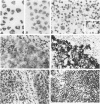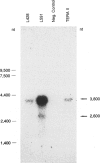Abstract
The expression, serological detection, and possible functional role of the CD30 antigen in Hodgkin's disease and anaplastic large cell lymphoma is well documented. In embryonal carcinoma (EC), the expression of this cytokine receptor has been demonstrated only by immunohistology. Because the CD30 monoclonal antibody Ki-1 was found to cross-react with an unrelated molecule, we examined by in situ hybridization testicular germ cell neoplasms for the presence of CD30-specific transcripts. CD30 mRNA was detectable in the tumor cells of 9 of 9 cases of EC or mixed germ cell tumors with an EC component but in no other nonlymphoid tumors. Thus, the CD30 transcript expression pattern proved to be identical to the immunostaining pattern seen with the CD30-specific monoclonal antibody Ber-H2. By Northern blot analysis, CD30 transcripts could be demonstrated in the EC cell line Tera-2. Employing a highly sensitive second generation sandwich enzyme-linked immunosorbent assay, we could detect the soluble CD30 molecule in 8 of 8 sera from patients with a diagnosis of EC but not in 8 of 10 sera from patients with other testicular germ cell tumors. In fetal tissue, no CD30-expressing germ cells or epithelial cells could be observed. Thus, the cellularly expressed CD30 marker for testicular neoplasms of EC type. Moreover, the serum levels of soluble CD30 antigen seem to be a promising parameter for monitoring patients with EC.
Full text
PDF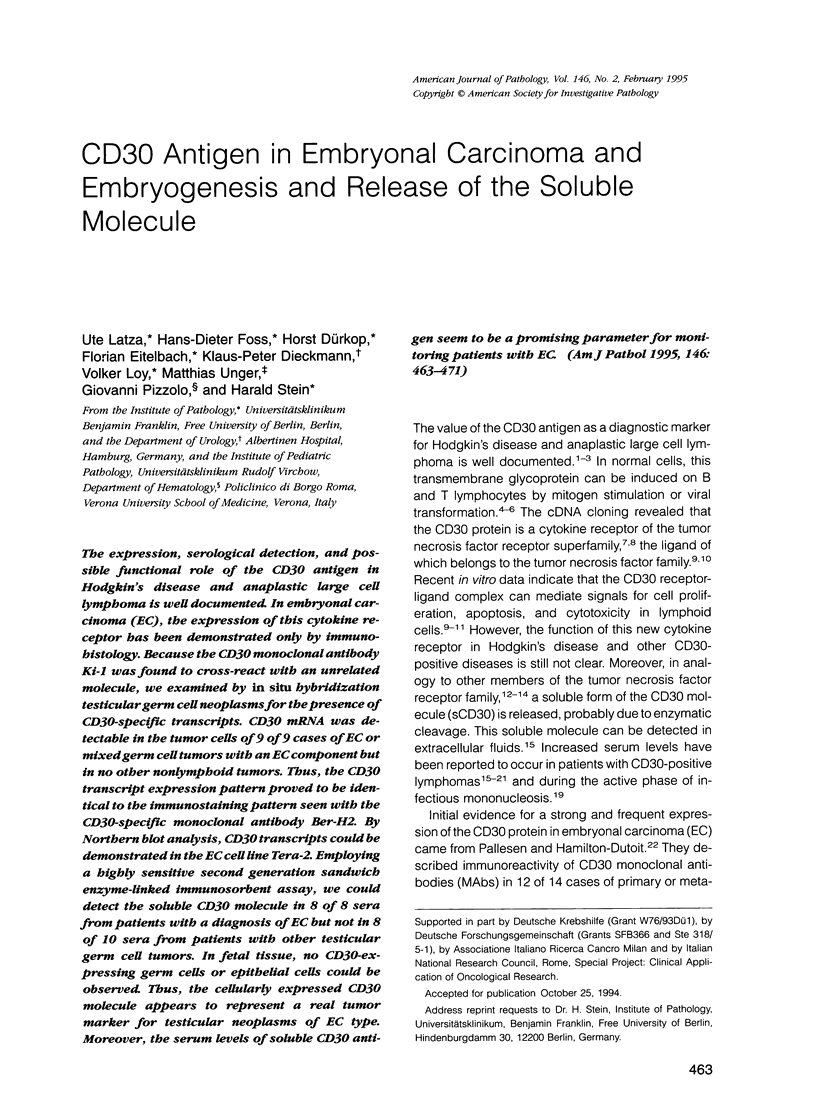
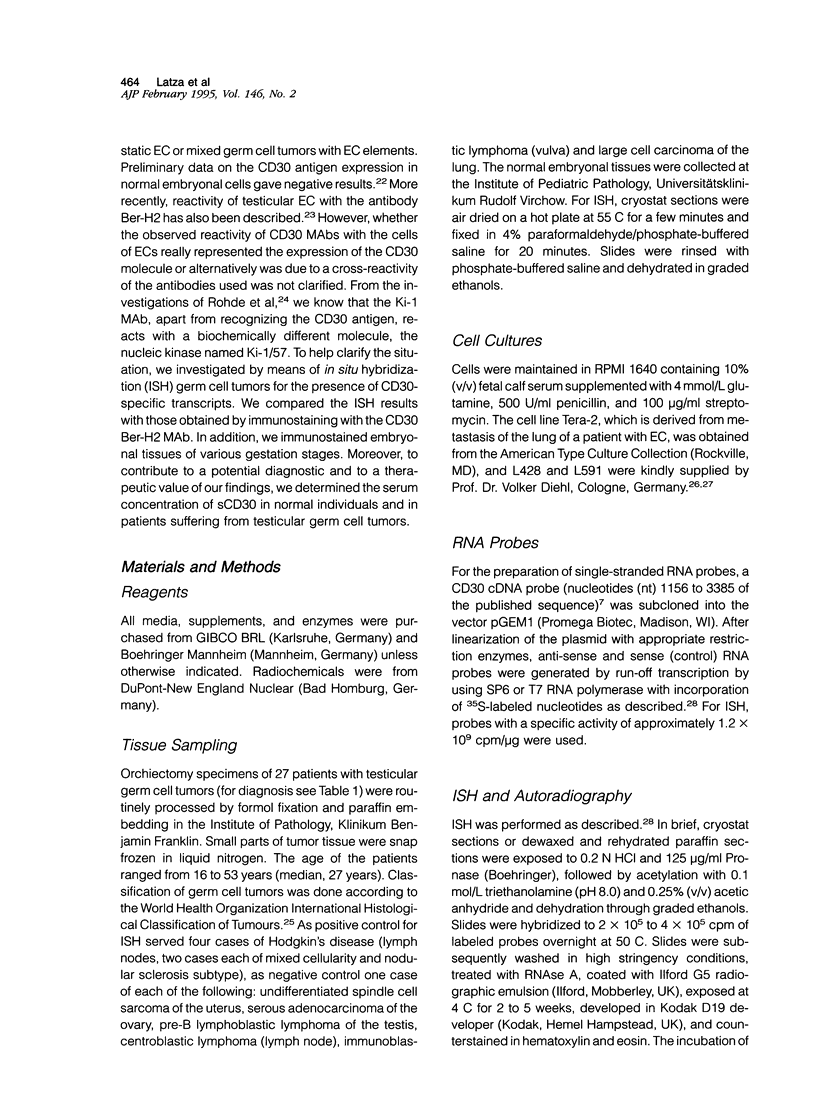
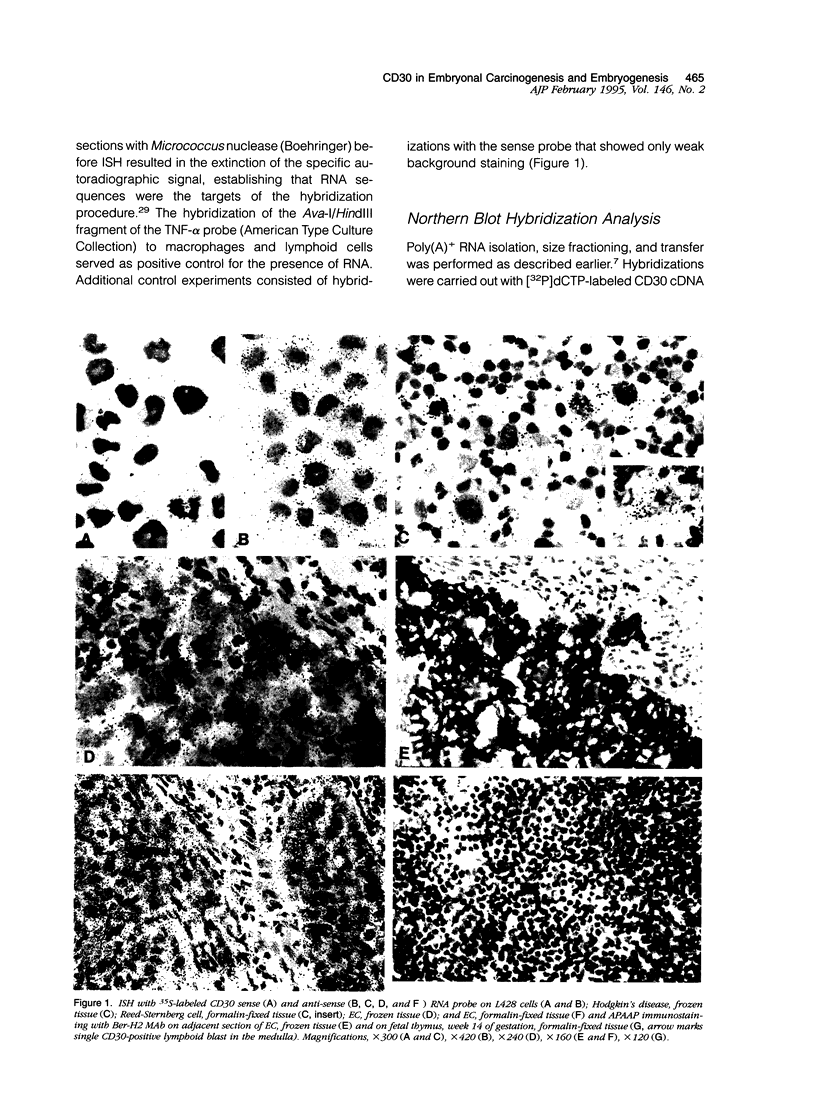
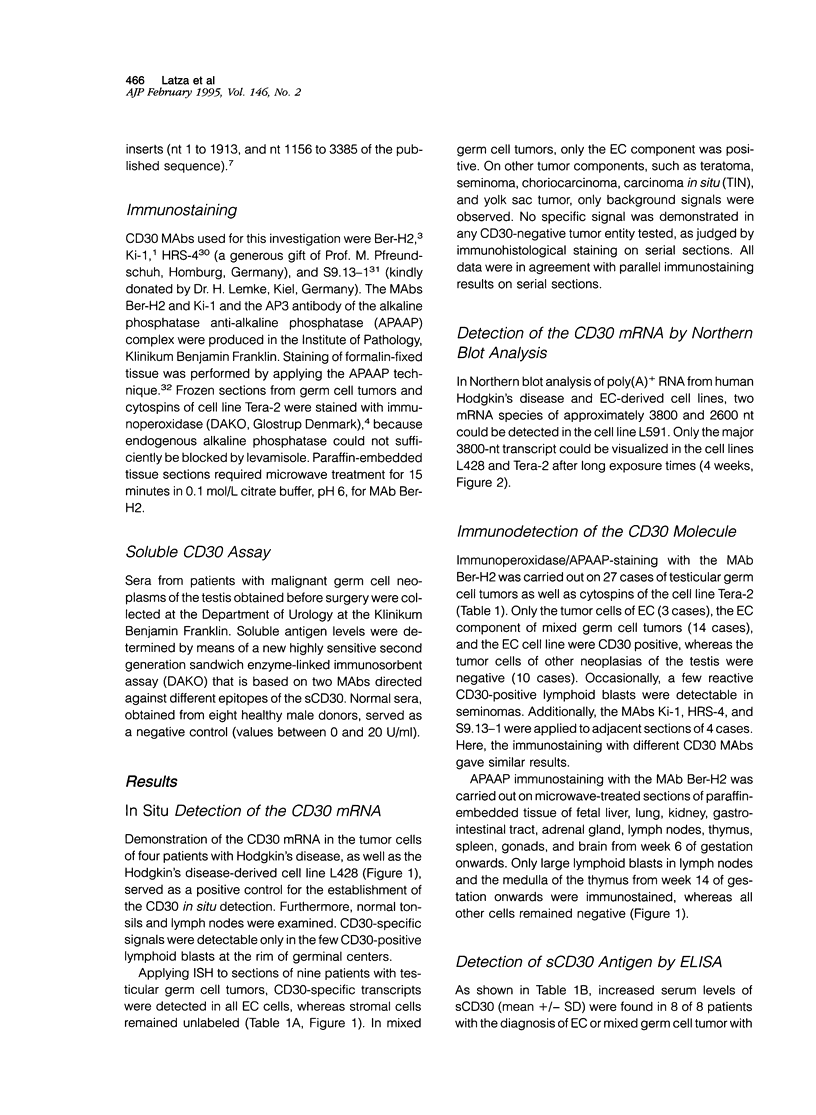
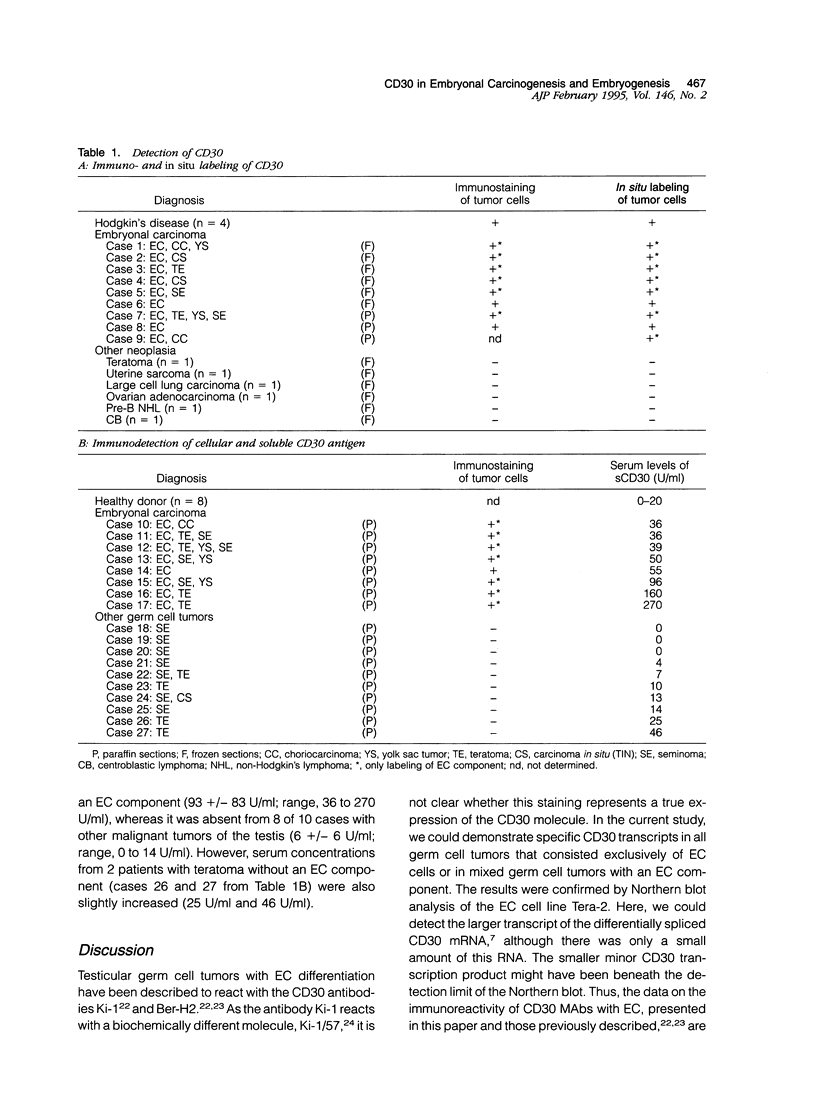
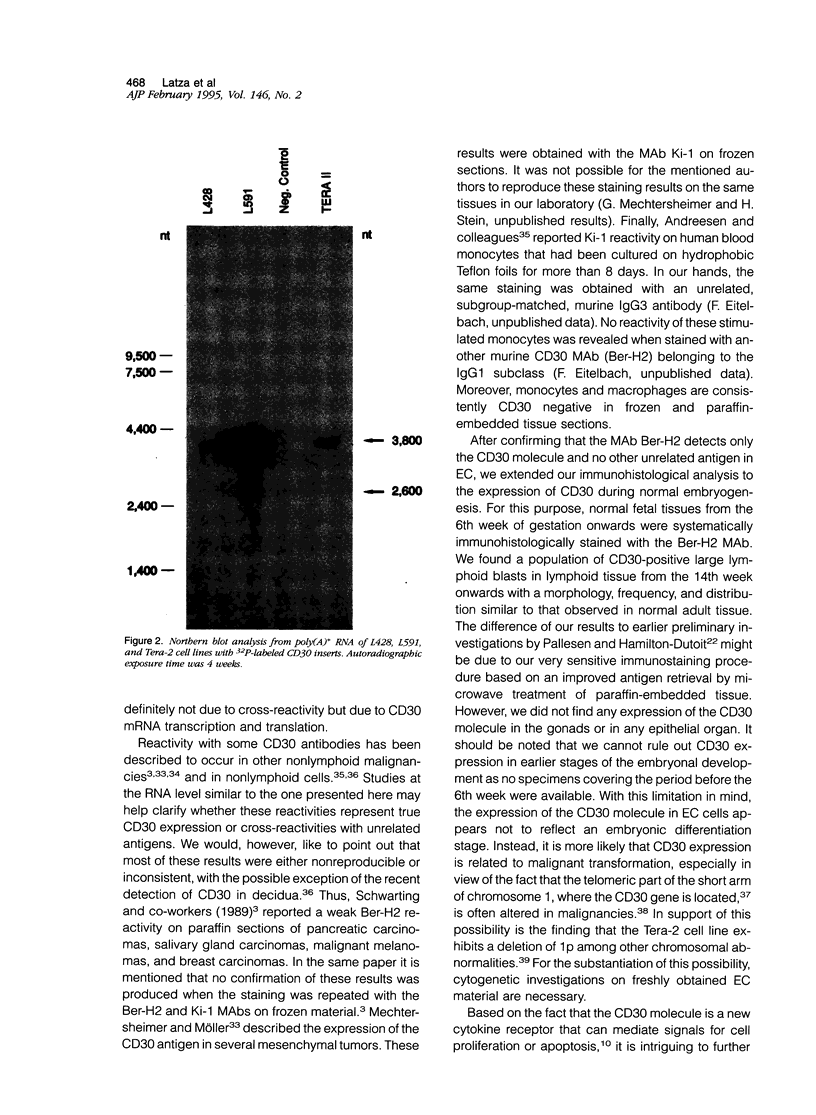

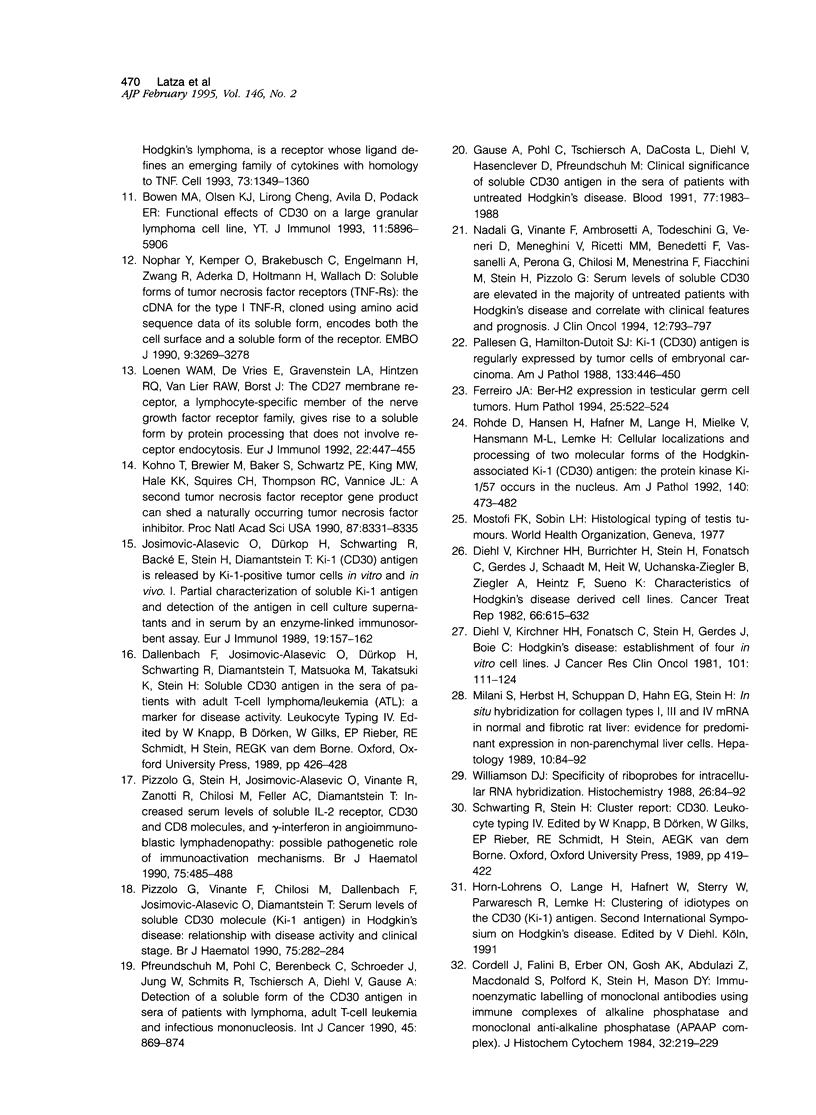
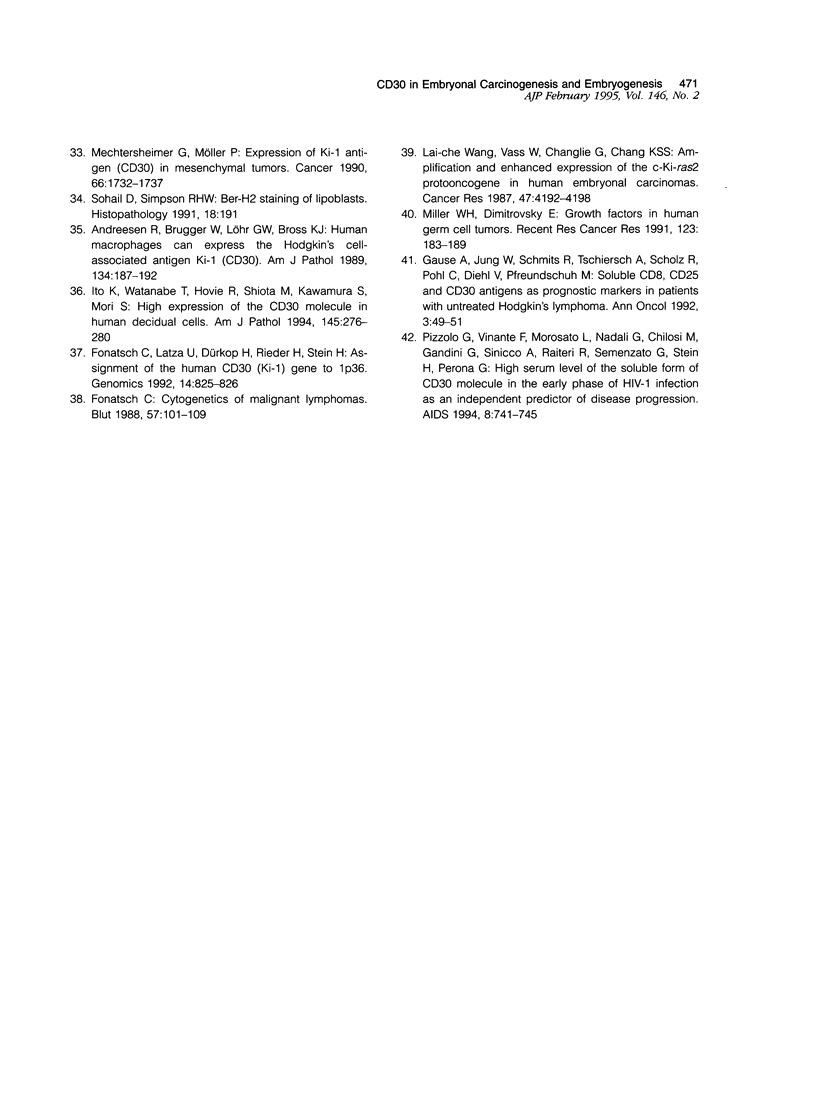
Images in this article
Selected References
These references are in PubMed. This may not be the complete list of references from this article.
- Andreesen R., Brugger W., Löhr G. W., Bross K. J. Human macrophages can express the Hodgkin's cell-associated antigen Ki-1 (CD30). Am J Pathol. 1989 Jan;134(1):187–192. [PMC free article] [PubMed] [Google Scholar]
- Andreesen R., Osterholz J., Löhr G. W., Bross K. J. A Hodgkin cell-specific antigen is expressed on a subset of auto- and alloactivated T (helper) lymphoblasts. Blood. 1984 Jun;63(6):1299–1302. [PubMed] [Google Scholar]
- Beutler B., van Huffel C. Unraveling function in the TNF ligand and receptor families. Science. 1994 Apr 29;264(5159):667–668. doi: 10.1126/science.8171316. [DOI] [PubMed] [Google Scholar]
- Bowen M. A., Olsen K. J., Cheng L., Avila D., Podack E. R. Functional effects of CD30 on a large granular lymphoma cell line, YT. Inhibition of cytotoxicity, regulation of CD28 and IL-2R, and induction of homotypic aggregation. J Immunol. 1993 Dec 1;151(11):5896–5906. [PubMed] [Google Scholar]
- Cordell J. L., Falini B., Erber W. N., Ghosh A. K., Abdulaziz Z., MacDonald S., Pulford K. A., Stein H., Mason D. Y. Immunoenzymatic labeling of monoclonal antibodies using immune complexes of alkaline phosphatase and monoclonal anti-alkaline phosphatase (APAAP complexes). J Histochem Cytochem. 1984 Feb;32(2):219–229. doi: 10.1177/32.2.6198355. [DOI] [PubMed] [Google Scholar]
- Diehl V., Kirchner H. H., Burrichter H., Stein H., Fonatsch C., Gerdes J., Schaadt M., Heit W., Uchanska-Ziegler B., Ziegler A. Characteristics of Hodgkin's disease-derived cell lines. Cancer Treat Rep. 1982 Apr;66(4):615–632. [PubMed] [Google Scholar]
- Diehl V., Kirchner H. H., Schaadt M., Fonatsch C., Stein H., Gerdes J., Boie C. Hodgkin's disease: establishment and characterization of four in vitro cell lies. J Cancer Res Clin Oncol. 1981;101(1):111–124. doi: 10.1007/BF00405072. [DOI] [PubMed] [Google Scholar]
- Dürkop H., Latza U., Hummel M., Eitelbach F., Seed B., Stein H. Molecular cloning and expression of a new member of the nerve growth factor receptor family that is characteristic for Hodgkin's disease. Cell. 1992 Feb 7;68(3):421–427. doi: 10.1016/0092-8674(92)90180-k. [DOI] [PubMed] [Google Scholar]
- Ferreiro J. A. Ber-H2 expression in testicular germ cell tumors. Hum Pathol. 1994 May;25(5):522–524. doi: 10.1016/0046-8177(94)90125-2. [DOI] [PubMed] [Google Scholar]
- Fonatsch C. Cytogenetics of malignant lymphomas. Blut. 1988 Sep;57(3):101–109. doi: 10.1007/BF00320147. [DOI] [PubMed] [Google Scholar]
- Fonatsch C., Latza U., Dürkop H., Rieder H., Stein H. Assignment of the human CD30 (Ki-1) gene to 1p36. Genomics. 1992 Nov;14(3):825–826. doi: 10.1016/s0888-7543(05)80203-4. [DOI] [PubMed] [Google Scholar]
- Froese P., Lemke H., Gerdes J., Havsteen B., Schwarting R., Hansen H., Stein H. Biochemical characterization and biosynthesis of the Ki-1 antigen in Hodgkin-derived and virus-transformed human B and T lymphoid cell lines. J Immunol. 1987 Sep 15;139(6):2081–2087. [PubMed] [Google Scholar]
- Gause A., Jung W., Schmits R., Tschiersch A., Scholz R., Pohl C., Hasenclever D., Diehl V., Pfreundschuh M. Soluble CD8, CD25 and CD30 antigens as prognostic markers in patients with untreated Hodgkin's lymphoma. Ann Oncol. 1992 Sep;3 (Suppl 4):49–52. doi: 10.1093/annonc/3.suppl_4.s49. [DOI] [PubMed] [Google Scholar]
- Gause A., Pohl C., Tschiersch A., Da Costa L., Jung W., Diehl V., Hasenclever D., Pfreundschuh M. Clinical significance of soluble CD30 antigen in the sera of patients with untreated Hodgkin's disease. Blood. 1991 May 1;77(9):1983–1988. [PubMed] [Google Scholar]
- Ito K., Watanabe T., Horie R., Shiota M., Kawamura S., Mori S. High expression of the CD30 molecule in human decidual cells. Am J Pathol. 1994 Aug;145(2):276–280. [PMC free article] [PubMed] [Google Scholar]
- Josimovic-Alasevic O., Dürkop H., Schwarting R., Backé E., Stein H., Diamantstein T. Ki-1 (CD30) antigen is released by Ki-1-positive tumor cells in vitro and in vivo. I. Partial characterization of soluble Ki-1 antigen and detection of the antigen in cell culture supernatants and in serum by an enzyme-linked immunosorbent assay. Eur J Immunol. 1989 Jan;19(1):157–162. doi: 10.1002/eji.1830190125. [DOI] [PubMed] [Google Scholar]
- Kohno T., Brewer M. T., Baker S. L., Schwartz P. E., King M. W., Hale K. K., Squires C. H., Thompson R. C., Vannice J. L. A second tumor necrosis factor receptor gene product can shed a naturally occurring tumor necrosis factor inhibitor. Proc Natl Acad Sci U S A. 1990 Nov;87(21):8331–8335. doi: 10.1073/pnas.87.21.8331. [DOI] [PMC free article] [PubMed] [Google Scholar]
- Loenen W. A., De Vries E., Gravestein L. A., Hintzen R. Q., Van Lier R. A., Borst J. The CD27 membrane receptor, a lymphocyte-specific member of the nerve growth factor receptor family, gives rise to a soluble form by protein processing that does not involve receptor endocytosis. Eur J Immunol. 1992 Feb;22(2):447–455. doi: 10.1002/eji.1830220224. [DOI] [PubMed] [Google Scholar]
- Mallett S., Barclay A. N. A new superfamily of cell surface proteins related to the nerve growth factor receptor. Immunol Today. 1991 Jul;12(7):220–223. doi: 10.1016/0167-5699(91)90033-P. [DOI] [PubMed] [Google Scholar]
- Mechtersheimer G., Möller P. Expression of Ki-1 antigen (CD30) in mesenchymal tumors. Cancer. 1990 Oct 15;66(8):1732–1737. doi: 10.1002/1097-0142(19901015)66:8<1732::aid-cncr2820660815>3.0.co;2-5. [DOI] [PubMed] [Google Scholar]
- Milani S., Herbst H., Schuppan D., Hahn E. G., Stein H. In situ hybridization for procollagen types I, III and IV mRNA in normal and fibrotic rat liver: evidence for predominant expression in nonparenchymal liver cells. Hepatology. 1989 Jul;10(1):84–92. doi: 10.1002/hep.1840100117. [DOI] [PubMed] [Google Scholar]
- Miller W. H., Jr, Dmitrovsky E. Growth factors in human germ cell cancer. Recent Results Cancer Res. 1991;123:183–189. doi: 10.1007/978-3-642-84485-0_19. [DOI] [PubMed] [Google Scholar]
- Nadali G., Vinante F., Ambrosetti A., Todeschini G., Veneri D., Zanotti R., Meneghini V., Ricetti M. M., Benedetti F., Vassanelli A. Serum levels of soluble CD30 are elevated in the majority of untreated patients with Hodgkin's disease and correlate with clinical features and prognosis. J Clin Oncol. 1994 Apr;12(4):793–797. doi: 10.1200/JCO.1994.12.4.793. [DOI] [PubMed] [Google Scholar]
- Nophar Y., Kemper O., Brakebusch C., Englemann H., Zwang R., Aderka D., Holtmann H., Wallach D. Soluble forms of tumor necrosis factor receptors (TNF-Rs). The cDNA for the type I TNF-R, cloned using amino acid sequence data of its soluble form, encodes both the cell surface and a soluble form of the receptor. EMBO J. 1990 Oct;9(10):3269–3278. doi: 10.1002/j.1460-2075.1990.tb07526.x. [DOI] [PMC free article] [PubMed] [Google Scholar]
- Pallesen G., Hamilton-Dutoit S. J. Ki-1 (CD30) antigen is regularly expressed by tumor cells of embryonal carcinoma. Am J Pathol. 1988 Dec;133(3):446–450. [PMC free article] [PubMed] [Google Scholar]
- Pfreundschuh M., Pohl C., Berenbeck C., Schroeder J., Jung W., Schmits R., Tschiersch A., Diehl V., Gause A. Detection of a soluble form of the CD30 antigen in sera of patients with lymphoma, adult T-cell leukemia and infectious mononucleosis. Int J Cancer. 1990 May 15;45(5):869–874. doi: 10.1002/ijc.2910450515. [DOI] [PubMed] [Google Scholar]
- Pizzolo G., Stein H., Josimovic-Alasevic O., Vinante F., Zanotti R., Chilosi M., Feller A. C., Diamantstein T. Increased serum levels of soluble IL-2 receptor, CD30 and CD8 molecules, and gamma-interferon in angioimmunoblastic lymphadenopathy: possible pathogenetic role of immunoactivation mechanisms. Br J Haematol. 1990 Aug;75(4):485–488. doi: 10.1111/j.1365-2141.1990.tb07786.x. [DOI] [PubMed] [Google Scholar]
- Pizzolo G., Vinante F., Chilosi M., Dallenbach F., Josimovic-Alasevic O., Diamantstein T., Stein H. Serum levels of soluble CD30 molecule (Ki-1 antigen) in Hodgkin's disease: relationship with disease activity and clinical stage. Br J Haematol. 1990 Jun;75(2):282–284. doi: 10.1111/j.1365-2141.1990.tb02664.x. [DOI] [PubMed] [Google Scholar]
- Pizzolo G., Vinante F., Morosato L., Nadali G., Chilosi M., Gandini G., Sinicco A., Raiteri R., Semenzato G., Stein H. High serum level of the soluble form of CD30 molecule in the early phase of HIV-1 infection as an independent predictor of progression to AIDS. AIDS. 1994 Jun;8(6):741–745. doi: 10.1097/00002030-199406000-00003. [DOI] [PubMed] [Google Scholar]
- Rohde D., Hansen H., Hafner M., Lange H., Mielke V., Hansmann M. L., Lemke H. Cellular localizations and processing of the two molecular forms of the Hodgkin-associated Ki-1 (CD30) antigen. The protein kinase Ki-1/57 occurs in the nucleus. Am J Pathol. 1992 Feb;140(2):473–482. [PMC free article] [PubMed] [Google Scholar]
- Schwab U., Stein H., Gerdes J., Lemke H., Kirchner H., Schaadt M., Diehl V. Production of a monoclonal antibody specific for Hodgkin and Sternberg-Reed cells of Hodgkin's disease and a subset of normal lymphoid cells. Nature. 1982 Sep 2;299(5878):65–67. doi: 10.1038/299065a0. [DOI] [PubMed] [Google Scholar]
- Schwarting R., Gerdes J., Dürkop H., Falini B., Pileri S., Stein H. BER-H2: a new anti-Ki-1 (CD30) monoclonal antibody directed at a formol-resistant epitope. Blood. 1989 Oct;74(5):1678–1689. [PubMed] [Google Scholar]
- Sohail D., Simpson R. H. Ber-H2 staining of lipoblasts. Histopathology. 1991 Feb;18(2):191–191. doi: 10.1111/j.1365-2559.1991.tb01471.x. [DOI] [PubMed] [Google Scholar]
- Stein H., Gerdes J., Schwab U., Lemke H., Mason D. Y., Ziegler A., Schienle W., Diehl V. Identification of Hodgkin and Sternberg-reed cells as a unique cell type derived from a newly-detected small-cell population. Int J Cancer. 1982 Oct 15;30(4):445–459. doi: 10.1002/ijc.2910300411. [DOI] [PubMed] [Google Scholar]
- Stein H., Mason D. Y., Gerdes J., O'Connor N., Wainscoat J., Pallesen G., Gatter K., Falini B., Delsol G., Lemke H. The expression of the Hodgkin's disease associated antigen Ki-1 in reactive and neoplastic lymphoid tissue: evidence that Reed-Sternberg cells and histiocytic malignancies are derived from activated lymphoid cells. Blood. 1985 Oct;66(4):848–858. [PubMed] [Google Scholar]
- Wang L. C., Vass W., Gao C. L., Chang K. S. Amplification and enhanced expression of the c-Ki-ras2 protooncogene in human embryonal carcinomas. Cancer Res. 1987 Aug 1;47(15):4192–4198. [PubMed] [Google Scholar]



